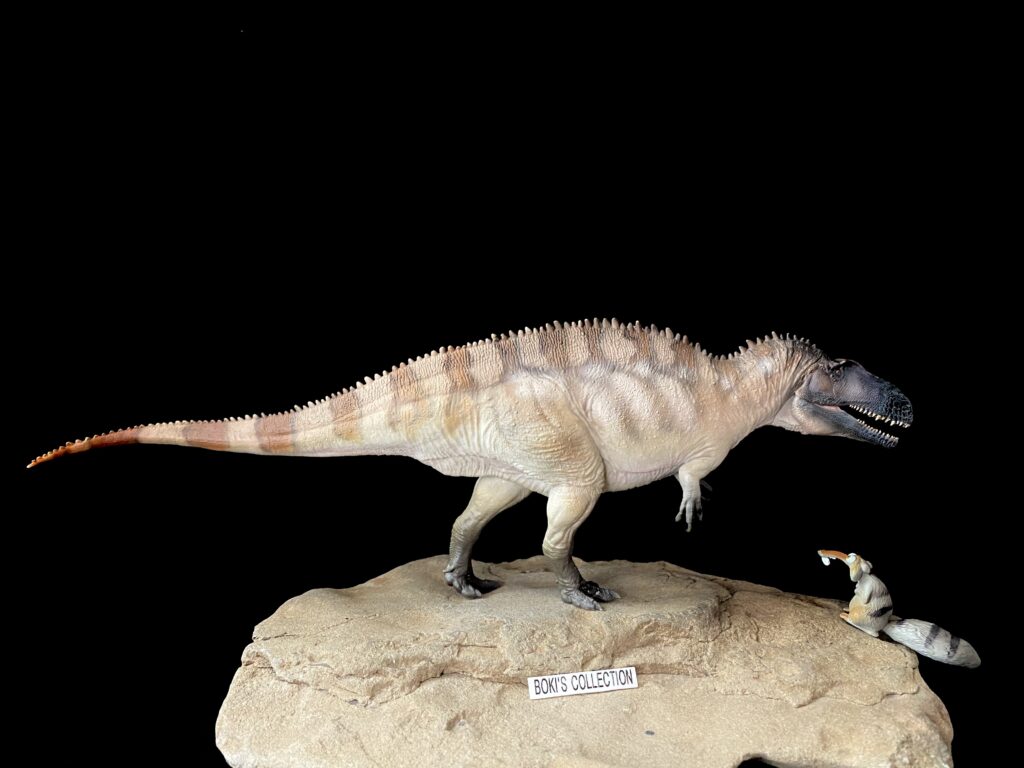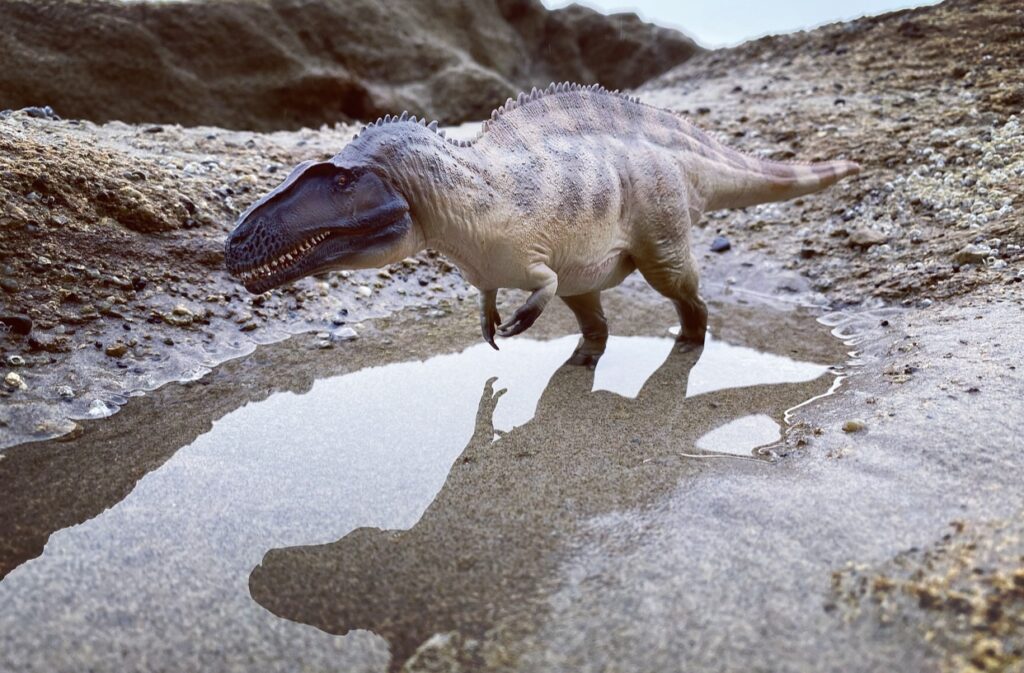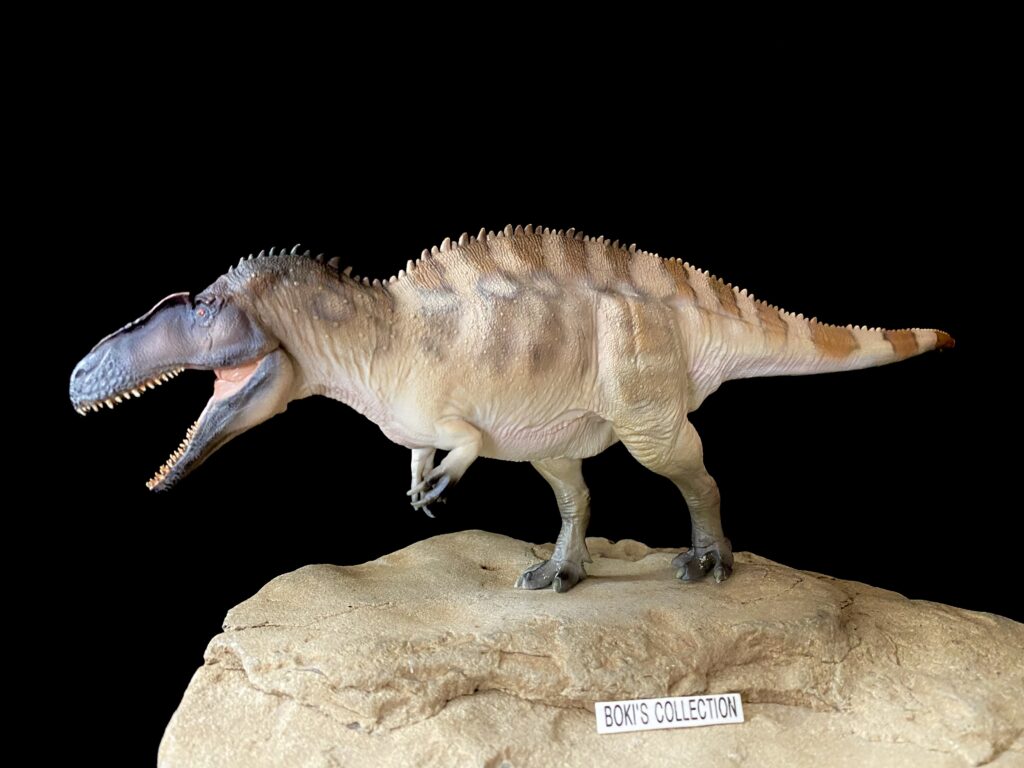Acrocanthosaurus? Chances are, if you are a dinosaur fan, you may be familiar with this predator and even be a big fan of it. But step out of the paleontology world and into the mainstream, many would not know what Acrocanthosaurus is. For a large and very unique looking dinosaur, it is a bit surprising that it hasn’t reach the same name recognition as some more generic looking theropods like say Allosaurus . It’s like an actor who has all the talent and star qualities but hasn’t yet landed the perfect movie role to propel it to stardom. Would its appearance in PNSO’s lineup help change that?


If I remember correctly, I believe the very first toy model of this dinosaur was introduced by Battat in the 90’s, that model would be the best for many years. Since then, there has been a slow trickle of other models from other brands, but for me, none of them surpassed the Battat ( Papo did make a striking one) …until now. After a long wait, PNSO finally released their take on this unusual theropod. Meet Fergus, PNSO’s Acrocanthosaurus, part of their Prehistoric Animas Models That Accompany Your Growth series and is number 61. He is part of PNSO’s lineup for 2022, an impressive and diverse group that ranged from the classic favorites to the controversial. So, let’s take a look at this enigmatic model.


Measuring at 12” long and standing 4” inches tall, he easily fits the 1:35 scale perfectly and display beautifully with other PNSO models of the same scale. Surprisingly, for a genus that’s been requested frequently, the release of this model didn’t generate as much excitement as I would have expected. Anyway, I was personally excited to see PNSO tackle this animal, and for me it didn’t disappoint.

The head has the unmistakable look of an charcarodontosaurid and matches the silhouette of the skull nicely. The model, like many PNSO offerings, is an explosion of wonderful details. The head showcases various scales of different shape and sizes depending on location. On the snout you will see the largest of these scales before they transition to very small and delicate ones as you move towards the rest of the head. There is a short ridge above the snout that terminate just above the eyes, not as tall or pronounced like the one we see on Allosaurus. In keeping with PNSO’s recent theropods, it does not have full lips, I’m sure many would be complaining about that. I personally don’t have a preference so this doesn’t bother me at all.


The jaw and associated musculature are beautiful done with no shrink wrapping. The teeth are individually sculpted and maintained their sharpness and shape even at this small size. The inside of the mouth showcases an abundance of details even in areas that are not normally visible like the roof. As for not having lips, I think I have repeatedly stated in various reviews that I personally don’t have any preference when it comes to this, especially when the jury is still out there. But if you fall on the side of preferring lips then you surely would have an issue with this model not having one. The small eyes are encircled by wrinkles and larger scales which perfectly frames the intensity of the orange eyes. The mouth is of course articulated and maintain its position nicely without sliding.


The neck is thick and powerful as it should be and you see the bulge of muscle just after the head. Plenty of skin wrinkles can be seen on the neck and throat area that suggests tension and flexibility as the head moves around. You also see the start of the single row of dorsal spines beginning at the base of the skull and runs all the way down the tail. These spines are all individually sculpted, different sizes, as well as some irregularities which adds an organic feel to the whole thing.

Moving on to the body, the unmistakable tall neural spines is what makes this theropod unique and distinctive. Tall neural spines are a common thing in many prehistoric animals with the most famous examples are those seen in Spinosaurus and Dimetrodon, and most recently Deinocheirus. We see these tall neural spines on many other less famous dinosaurs such as Ouranosaurus and on some sauropods. The tall neural spines are often depicted as holding up a sail on the animal’s back. This of course depends largely on how long these spines are and their shape.


On Acrocanthosaurus, these tall neural spines are not as extreme as those seen on Spinosaurus. This has lead many to believe that on Acrocanthosaurus, the shape looks more like that of the extant Bison, meaning more like a hump rather than a full sail. This makes Acrocanthosaurus so visually unique among large theropods and make it appear taller. PNSO gave their model a nice and very impressive hump that gradually attain height as it moves down the body. This gradual transition is pleasing visually and avoid the extremes that we often see on other models. Where these tall neural spines begins are very well marked by the musculature on the back that clearly outlined their location on the back. This sail-like hump is muscular and maintain these all the way down towards the base of the tail. There is even an extra muscle bulge on the tail base that suggests strong attachment which is nice to see. The tall neural spines are the highlight of this dinosaur and PNSO has done a great job in showcasing these.

The main body is robust and deep. The scales covering the body are so small, delicate , and beautifully rendered. Mixed in with these delicate scales are larger ones or scutes/osteoderms that add variety and textures. Topping it all off are the abundant skin folds and wrinkles, some big, some small and subtle that all comes together to give the body a nice sense of fluidity and movement. The arm looks about the right size and proportion with one arm held slightly above the other. The claws are sculpted nicely and surprisingly very sharp! You won’t see an enlarged claw like in Allosaurus, as far as I know Acrocanthosaurus didn’t have them. The legs are proportional to the body and once again are more robust than that of Allosaurus. The feet are planted firmly on the ground.


The tail when seen at various angles may look short, but that’s just an illusion. In person one can easily appreciate its true proportions. The tail is powerful as indicated by the abundant muscle seen up and down the entire length. There is slight curvature on the tail that gives it a sense of movement.Like the majority of biped models from PNSO, this once also comes with a clear rod that is used to support the figure. The model itself can stand perfectly balanced on its feet, but due to its proportions, not as stable and easily fall at the slightest vibration. The rod when used not only stabilized the figure but also protects and prevents the legs from warping overtime. It’s the curse of bipedal models especially those with heavy front end like this one.

Now for the colors. It’s hard to review PNSO models without starting to sound repetitive. One can’t help but appreciate the way PNSO does the paint application on their models and this is no exception. While the color palette remains within the earth tone browns, there are plenty of shades and hues that add a richness that is not seen in earlier models.The overall base color are light beige brown that transitions into various shades as it radiates into the different body parts. On the back, we see a dark brown outlining the upper most part of the body. This slowly transition to a lighter shades as you move down towards the torso and belly. This dark brown is interrupted by a beige color in an alternating elongated spots creating a visually appealing strip of some sort.

A grayish color forms a dark horizontal band or watermark that separates the dorsal colors from the torso . Below this band the same colors and patterns are repeated but now looks more blurred ( the watercolor effects) and not as crisp as the ones above as they slowly blends with the lighter colors of the torso and finally fading as it merges with the light browns of the stomach and belly region.The head is charcoal/ Smokey gray color which contrast with the beige browns of the main body. It also makes the vivid orange eyes really pop out dramatically. To add depth, layers of brown, yellow, orange, gray, and even perhaps purple/ blue are all mixed in with the charcoal color in a very subtle but effective way.

Like many PNSO models, there are a lot more layers and complexities than first meet the eyes in this model, in fact there could be more due to the multi-layer approach to painting. Despite the dominance of the beige color, mixed in are white, yellows, black, and multiple blends that all add depth to the entire color palette. The pattern designs are also striking and very reminiscent of a rattlesnake. I would argue that this is the most elaborate and best color scheme on all PNSO predatory theropods to date.

There is no doubt that this model exudes a real unique and imposing presence in a display shelf. It stands out amongst all the PNSO theropods. It’s wonderful to finally get a contemporary interpretation of this unique dinosaur, now if only we could get some of the other dinosaurs that lived alongside it to give it company. In all honesty, I never really gave that much thought about Acrocanthosaurus and all the figures released before this have never really excited me. But the arrival of this exquisite model changed that and I find myself intrigued by this enigmatic dinosaur.


PNSO has given us a long parade of theropods and this model is just one of the latest to join the crowd. With so many beautiful models competing for attention, it’s easy to overlook this figure. But for me, it definitely hold its own and worth stopping and admiring the nuances and artistry that abound. Well, that concludes our review, thank you for reading and hope you enjoyed it. Until the next one, stay safe and healthy. Cheers!

Disclaimer: links to Ebay and Amazon on the DinoToyBlog are affiliate links, so we make a small commission if you use them. Thanks for supporting us!




comment ça le papo acrocanthosaurus n’est pas parfait moi Personnellement je le trouver très bien fait
Spectacular photos. So life like.
Great Photographs!
That photo of the Acrocanthosaurus walking along the beach is gorgeous.
I think that it’s a superior figure too. I suspect that it’s relatively low key entry into the market was due to the large number of PNSO theropods that had been released fairly recently and also the negative comments made about the alleged shortness of the tail, which has turned out to be due to the angle of view and height of the spines above it at its forward end. It certainly supercedes the classic Battat, which was always my iconic Acrocanthosaurus.
I think you’re right that the Battat was the first (barring perhaps some porcelain statues or similar items), and it holds up really well, actually! I wonder if the relative lack of hype around the PNSO Acro figure was exactly because it was released amid a flurry of other theropods and got drowned out a bit. I think it’s a great figure, I own it, I can see it on my shelf, but I barely remember unpacking it from its box.
Anyway, great review, thanks for the very thorough visuals!